This website is supported by its readers. If you click one of my links I may earn a commission. I am also a participant in the Amazon affiliates program and I will also earn a commission from qualified purchases.
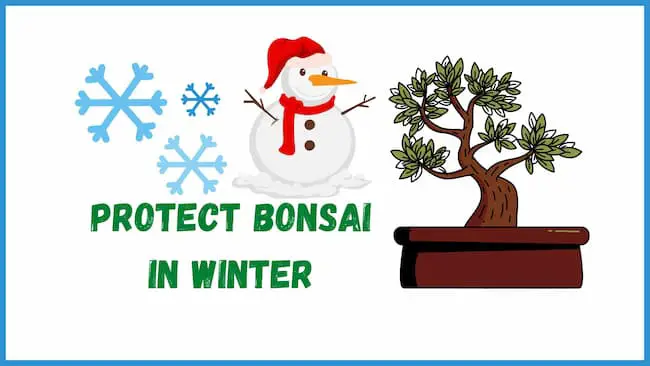
With winter fast approaching, one of the questions I’m asking myself is how to protect bonsai in winter. After all, I have several different species and sized bonsai trees. So are there universal rules I can follow to protect these bonsai in winter?
Leaving your bonsai tree in an outdoor shelter is the best option to protect your tree during winter. Keeping your bonsai under a bench or in a cold frame that you cover with a tarp or bubble wrap so the wind and elements cannot penetrate will be the best option for most bonsai tree species.
Bonsai tree species, such as Ficus or Chinese Elm, should remain indoors during the winter. However, most outdoor trees are hardy enough to survive winters in mild climates.
Protecting your bonsai during winter is commonly referred to as overwintering bonsai or overwintering bonsai. Overwintering typically consists of burying your bonsai to protect its roots or following one of the other methods in this post.
So what exactly is the science behind why you should protect your bonsai during winter? And which method works best? Keep reading to find out more!
Just a quick heads up, over the past three years of running Plantpaladin, hundreds of people have asked for product recommendations. As such, You can find my favorite indoor bonsai tree here (link takes you to Bonsaiboy), my favorite outdoor bonsai tree (link takes you to Bonsaiboy), or have a look at all the products I recommend here.
How to protect bonsai in winter?
Easily one of the scariest moments for any new bonsai owner is managing their first winter.
Most bonsai trees are suitable for outdoor conditions, so we must consider how to look after your bonsai during winter.
The good news is that I’ve successfully managed to guide my bonsai through winter several times.
As such, I got in touch with my local botanical gardens, spoke to ten plant paladin readers, and even spoke to a few bonsai experts to confirm if the techniques and tips I followed were correct.
All this is to ensure you have the best post on how to protect bonsai in winter on the web.
To summarise:
Protect bonsai in winter – quick facts
- Most bonsai trees can be kept outdoors during the winter without needing protection.
- Bonsai trees are hardy and can handle a few weeks of sub-zero temperatures.
- If your climate drops below 15 degrees Fahrenheit or -10 Celsus, then even the hardiest bonsai species, such as Juniper, will need some winterizing.
- Most bonsai trees that need winterizing, however, can be left outdoors.
- To winterize an outdoor bonsai tree, move your bonsai tree to a location that gets protection from rain and snow.
- An example of this would be under a bonsai bench or chair.
- Then protect the bonsai tree from the elements by covering the top and side of the bench with bubble wrap or a tarp.
- Alternative methods include using wind guards to protect your bonsai, building a wooden frame around your bonsai, or moving your tree to a cold room or shelter in your house, such as a garage without a heater.
- Consider building cold frames to prevent winter damage in climates where winters are particularly bitter, dry, and cold.
- Bonsai trees that will benefit from outdoor winterization if temperatures drop low enough include Juniper, Pine, Scott Pine species, Oak, Maple, Acer, and Willow trees.
- However, the major exception to this role is bonsai trees, which prefer bright warm conditions.
- These trees typically originate from warmer climates, and so do species such as Olive or Ficus species.
- These species and other bonsai, typically grown indoors, such as Elm trees, Fukien tea, or succulents such as Jade, should all be kept indoors during winter too.

Let’s explore all this in more detail:
What to know before winterizing your bonsai tree?
So before we start any techniques to help winterize your bonsai tree, you need to consider a few key points beforehand.
Understanding these will help decide the level of winter care needed for your bonsai tree.
Following these steps will prevent you from making overly cautious decisions and over-winterizing your bonsai tree, which can be just as bad as not protecting your bonsai during winter.
Understand what your bonsai species is
Understanding bonsai species is the most significant misconception people ( myself included) have about bonsai winter care.
Often we think that all bonsai trees require protection during winter or can’t be left outside during cold temperatures.
This is simply not true.
Bonsai trees will typically fall into two main categories
- Indoor bonsai trees.
- Outdoor bonsai trees.
Indoor bonsai trees tend to be more beginner friendly, require warmer temperatures to thrive, and like a lot of sunlight.
These trees then are usually deciduous or semi-deciduous, losing their leaves for a few weeks during the year.
Indoor trees then include Chinese Elm, Ficus, and Jade species.
Outdoor bonsai trees are typically more suited to colder conditions and can usually be left outdoors year-round.
These trees tend to be evergreen, so species such as Juniper, Pine, or Cedarwood work very well as outdoor bonsai species.
So what does winterizing these different species look like
Well, winterizing these trees typically looks very different depending on if your tree is more suited to being an outdoor bonsai than an indoor bonsai tree.
Indoor bonsai
Indoor bonsai trees should be left indoors during winter as they usually require much warmer temperatures to survive.
These trees are used in tropical climates, so unless you live in a climate with year-round temperatures above 25 degrees Celsius or 77 degrees Fahrenheit, these trees will need to be kept indoors year-round.
Keep them in your house near a south-facing window to protect these trees so they get a lot of light.
Aim for these species to try and get as much sunlight as possible, investing in a bonsai grow light if needed.
Try to aim for these trees to have the same temperature year-round, so try to modulate your heating so it does not produce overly dry air that may dry out your bonsai.
Outdoor bonsai
Bonsai species more suited to the outdoors will require more stringent winterizing depending on how low temperatures become.
If winter temperatures only drop below 0 celsius for a few nights, most outdoor bonsai tree species will have no problem.
Suppose temperatures regularly drop below zero during winter nights for a few weeks. In that case, a more significant winterization will be required – either moving the trees into a cold spot or protecting them via a shelter.
Bonsai species that need to be protected in winter
Chinese Elm, Ficus, and Fukien tea species of bonsai should all be kept indoors during winter. Hardier outdoor bonsai species that are used to being kept in the cold, such as Juniper, pine, or cedar trees, should all be protected if temperatures drop below 15 degrees Fahrenheit or -10 for prolonged periods.
Most outdoor bonsai species will need winter protection depending on how cold the winter gets.
This will vary from simply planting bonsai pots in the ground to building cold frames and moving bonsai indoors.
I appreciate that many of you new to bonsai might be unfamiliar with your bonsai species.
To help, I’ve created a table below, which shows some of the most common bonsai species used outdoors or indoors and what degree of winterization it requires.
Bonsai species | Type | Winterization required |
Ficus | Indoor | Move into an indoor spot which remains the same temperature during winter. Place near a south facing window where possible. |
Chinese Elm | Indoor | Move into an indoor spot which remains the same temperature during winter. Place near a south facing window where possible. |
Juniper | Outdoor | Keep outdoors or in cold spot |
Jade | Indoor | Move into an indoor spot which remains the same temperature during winter. Place near a south facing window where possible. |
Maple | Outdoor | Keep outdoors or in cold spot |
Oak | Outdoor | Keep outdoors or in cold spot |
Willow | Outdoor | Keep outdoors or in cold spot |
Cherry | Outdoor | Keep outdoors or in cold spot |
Acer | Outdoor | Keep outdoors or in cold spot |
Olive | Indoor | Move into an indoor spot which remains the same temperature during winter. Place near a south facing window where possible. |
Fukien Tea | Indoor | Move into an indoor spot which remains the same temperature during winter. Place near a south facing window where possible. |
Understand how cold your climate gets in winter
So now you know the general rules about bonsai species, the second primary consideration you have to make is exactly how cold winters get where you live.
After all, winters in Siberia will be much colder than in Florida.
For example, I live in the UK, where typically, most winters won’t get much colder than -10 degrees Celsius.
The methods I’ve laid out will work for most temperate climates similar to mine. For example, I will talk about one of the methods later: keeping your bonsai in a box.
In countries and places where temperatures get much colder than -10 degrees Celsius, you may need to consider using more insulation or thicker boxes or, better yet, keeping your bonsai in a temperature-controlled greenhouse or cold frame.
If you are on the other end of the spectrum in a country where your winters are very mild or you have the same temperature year-round, your bonsai will likely not need winter protection.
Understanding what a typical winter looks like for you will set you up for success.
A good rule is around six weeks to one month before the worst of your winter should be when you start making these preparations to winterize your bonsai.
Now I know a lot of you might be unsure of just how cold the winter get’s in your state.
Luckily I’ve linked to the USDA hardiness zone, which shows average low temperatures for all of the States in the USA.
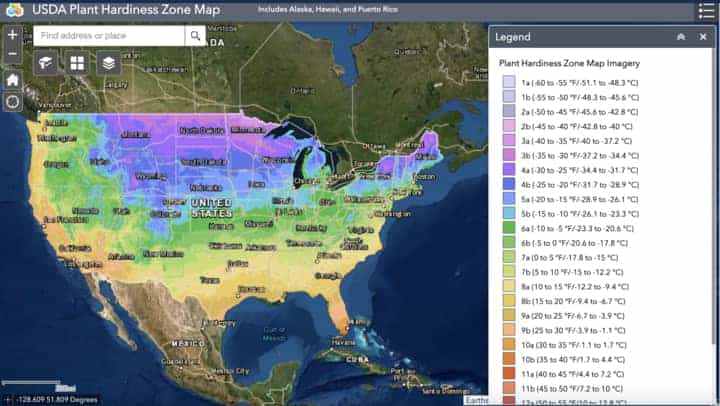
Prepare and fertilize your bonsai during the summer
Another prominent step people miss when winterizing bonsai trees is the work that needs to happen months before winterizing your bonsai.
One step many beginner bonsai keepers miss is simply fertilizing their bonsai trees.
The primary way bonsai trees that are kept outdoors stop themselves from freezing in winter is from the sugars, carbohydrates, and other minerals they secrete during the cold months.
Now bonsai trees can only produce this from the stored energy they have, which has been fed to them by fertilizer.
As such, during the spring and summer, you must add fertilizer to your bonsai tree.
Typically once per month between March to September will work best.
Both liquid or solid fertilizers can be used; however, aim for a fertilizer with an even N-P-K ratio to ensure the soil PH level does not change too much.
Avoid fertilizing your bonsai during winter, as this can cause burns to your tree.
Take note of the size of your bonsai tree.
Unfortunately, size very much matters when protecting bonsai trees during the winter.
Bonsai trees the most at risk when it comes to cold winters are trees that are smaller in size.
One-handed bonsai such as Keshitsubo or Shito are the trees that will need the most protection.
Typically if you have something such as a fingertip-sized bonsai tree, I would almost always move these trees indoors into a cold spot such as a garden or cold frame in the middle of the fall.
More giant bonsai trees will usually be more adept at dealing with cooler temperatures, so winterizing can be undertaken much later – typically six weeks away from the coldest part of the winter.
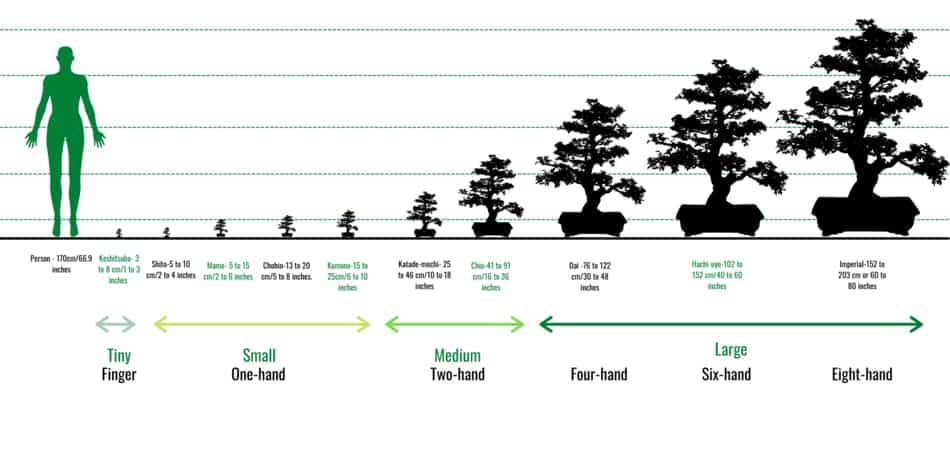
Understand the rainfall
While the snow may cause your bonsai to freeze, the wind causes your bonsai to dehydrate. One of the other significant factors that not enough people consider before winterizing their bonsai trees is how wet winter can get.
As such, if you leave your bonsai tree out during the winter, even if you don’t need to protect your bonsai from the cold, you need to take precautions so that you don’t overwater your bonsai tree.
While rainfall benefits bonsai, overwatering can lead to waterlogged potting soil, leading to an overwatered bonsai tree.
If nothing is done about this, you will get root rot in your bonsai and nasty fungal infections that some bonsai trees might not recover.
Even if you have mild winters, I would consider some shelter for them, such as under a bench.
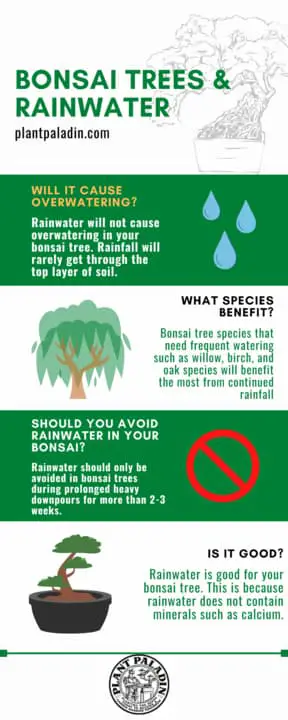
Take note of the length of winter
Another critical consideration is to get an idea of the length of winter.
We touched upon this earlier, but if temperatures only drop to below zero degrees celsius for a day or two in the entire winter, there is a good chance that outdoor hardy bonsai trees won’t need to be winterized.
If temperatures drop too low for too long, say a few days, your bonsai may face significant damage.
Take note then using the USDA guidelines on what the typical length of winter and colts temperatures look like for your location and make judgments accordingly.
Don’t rush the winterization process
Finally, the last thing to consider before winterizing your bonsai tree is simply not rushing the process.
Ideally, I like to start winterizing on my outdoor bonsai trees about six weeks before the coldest period.
Winterizing too quickly or on the day of, say, a snowstorm will leave it too late and not give your bonsai tree a chance to adapt to the colder temperatures.
Be aware that most outdoor bonsai tree species require cold temperatures to enter their dormancy period, which is vital to the tree’s overall health.
As such, it is vital only to start winterizing your bonsai when temperatures are genuinely low rather than when they are above freezing.
Winterizing your bonsai too early or when the temperature is too cold will impact its growth in the following season.
How to protect your bonsai during winter
So now we know what you need to know before winterizing your bonsai. What step-by-step methods do you need to follow to protect your bonsai trees during winter?
As mentioned, this will vary depending on if your bonsai tree is an indoor or outdoor bonsai.
How to protect indoor bonsai trees during winter?
To protect your indoor bonsai tree during winter, keep it in a temperature-controlled room. Place near a south-facing window so your tree gets as sunlight and water as you usually would.
Most indoor bonsai trees do not go through winter dormancy because the countries they originate from do not get cold enough to require a winter dormancy period.,
Managing the internal temperature is the main thing you must focus on when winterizing indoor bonsai trees such as Elms or Ficus trees.
In winter, we often like to turn on the heating.
While this keeps us warm, it tends to dry the air out, preventing your bonsai from getting valuable nutrients in the surrounding air.
Turning the heating on and off will vary the temperature that indoor bonsai trees are exposed with
The best things you can do to protect indoor bonsai in winter are to:
- Keep your bonsai in one location and try not to move them too much.
- Aim to keep the surrounding temperature the same during the winter.
- Ensure your indoor bonsai get’s plenty of daylight – these tropical trees require a lot of sunlight, so place them near a south-facing window where possible,
- Consider investing in a grow light to add to your tree’s light needs if you have no access to windows.
- Water your bonsai tree as you would usually during the winter – potentially slowing down to around once per week if the cold temperatures start to impact the tree.
How to protect outdoor bonsai trees during winter?
So unlike indoor bonsai trees, caring for outdoor bonsai trees during winter is a little more complex.
This is because several methods vary in their protection level.
Not all tree species will require the most severe levels of winterization, and over-winterizing your bonsai tree may even cause more damage to your outdoor bonsai tree than benefit.
The following are the best methods to winterize your outdoor bonsai tree.
- Cover with tarp
- Provide shelter and cover
- Use a styrofoam box.
- Hay bales
- Plant in the ground
- Move indoors into a cold spot.
- Create a cold frame
- Create a greenhouse
I’ve put together a table highlighting when you should use each method.
Let’s explore these in more detail:
Bonsai winterization method | When to use |
Cover with tarp | Mild winters only (between 0 to 5 degrees C) |
Provide shelter and cover | Mild winters only (between 0 to 5 degrees C) |
Styrofoam box | Moderately cool winters (between -5 to 0 degrees) |
Hay bales and wood frame | Moderately cool winters (between -5 to 0 degrees) |
Plant in the ground | Moderately cool winters (between -5 to 0 degrees) |
Move indoors into a cold spot | Severe winter (-20 to -5 degrees C) |
Create a cold frame | Severe winter (-20 to -5 degrees C) |
Create a greenhouse | Severe winter (-20 to -5 degrees C) |
Acer | Outdoor |
Olive | Indoor |
Fukien Tea | Indoor |
Cover with a tarp or netting
So the first method to help protect your outdoor bonsai in winter is to cover it with a tarp or netting.
This option works well without worrying about excessive rainfall or temperature drops. Instead, you want a light layer of waterproofing protection on your bonsai tree during tepid winter nights.
Using netting or a tarp is also relatively inexpensive compared to other methods.
Cover the topsoil of your potting soil to add mulch to it.
Then, simply drape over your plants to ensure any unwanted snow or rainfall does not damage your plants too much.
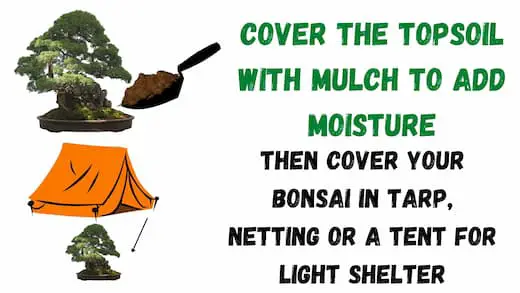
While many of you might already have waterproof sheeting at your disposal, a great option would be the Xpose Clear Poly Sheets ( link takes you to Amazon), which can be used for many different purposes and is weather resistant.

You can add other methods to this to add extra protection, such as keeping it in a box or wood frame.
Remember that this option will usually be the first option you follow.
Provide shelter and cover
The second method to protect outdoor bonsai in winter is to provide shelter and cover outdoors for your tree.
I find the best way to follow this method is to simply move your bonsai tree under a bonsai bench you may be using.
Moving under a bench will protect the tree from any general rainfall and snowfall.
Move your tree under a bench or space where it gets a light shelter, such as a pagoda.
Then cover the topsoil with mulch to prevent the soil from drying out.
I would finish by covering the bench with a tarp or netting, as discussed in the above step.
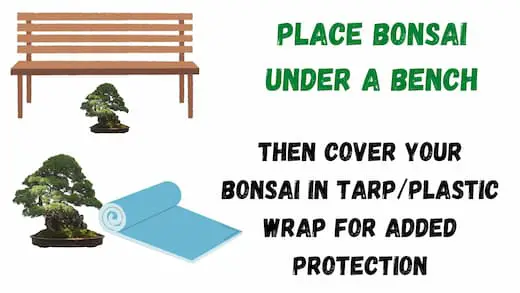
Use hay bales or a wood frame.
Now while the above method works well for more general cover, one of the big problems we have to contend with during winter is excessive wind.
This can cause the dry air to strip away your tree, causing significant damage to your tree and dehydrating it in the process.
If you need to level up the winter protection, the next thing I would do is to build a perimeter around your bonsai tree.
The good news is that this can typically be undertaken with natural materials.
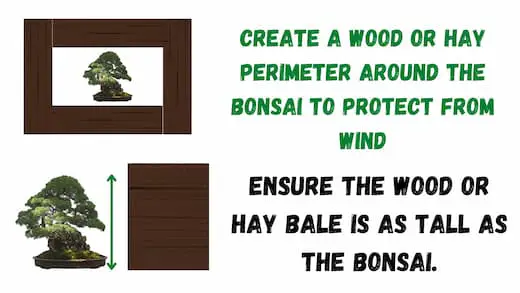
Using a wood frame
To use wood, Ensure that this frame is 6 to 12 inches high and that your bonsai fit right in the center of your frame.
You will also want to invest in waterproof wood, so solid hardwood works best. For my recommendation, check out this cherry lumbar (the link takes you to Amazon), which comes in various sizes.

Then simply use a mallet or hammer to build a wood perimeter around the bonsai tree, digging it into the ground to add stability.
Just keep in mind that if your bonsai is on the larger side, you may need to drill a few of these together to ensure that the wall of your frame is high enough to protect your bonsai.
This will protect the wind from attacking your tree.
Finish off by covering the topsoil with mulch to prevent the topsoil from dehydrating and att tarp or netting to prevent severe rainfall.
Using hay bales
Now, if your bonsai tree is more significant (I’m thinking something like an imperial-sized bonsai) and you have the space, I would strongly recommend using hay bales.
These are inexpensive and will provide added insulation to your bonsai.
Even better, hay is environmentally friendly, breaking down over time.
Like wood, create a perimeter around your bonsai, ensuring it stays in the middle.
Place your bonsai tree in the middle and cover it with mulch and netting.
Here is my recommendation for hay bales (the link takes you to Amazon).
Be warned; however, it is more complicated and may not be the best option in extreme winters.
Also, be prepared to have a lot of winter animals take refuge in your hay spot, as they will often feed on hay when other food sources become scarce.
Consider a wind guard
If you do decide to opt for the wooden frame or hay option, one additional item you may need to look into is investing in a wind guard.
Wind you see can severely dehydrate your plants in a phenomenon known as wind scorch, with even every green tree bearing the brunt of this.
Invest in a wind guard to prevent your leaves from permanently drying out or causing unnecessary damage.
I recommend the Barton Fire Pit (link takes you to Amazon), which works partially to block out damaging gusts and doubles up as a fire guard. This wind guard is also a fantastic option as it is about the right size as most average bonsai.

Plant in the ground
One of the primary conditions you must deal with is protecting the root structure of your bonsai tree.
A rapid method of protecting your outdoor bonsai tree, if you don’t want to place it in a box, is to plant your bonsai tree in the ground simply.
The good news is that you won’t have to remove your bonsai from the pot.
Instead, simply dig a hole big enough for your bonsai pot.
Then place your bonsai in the ground until only the trunk sticks out from the ground.
Cover the remaining topsoil with mulch.
This will protect the roots of your bonsai from the elements without impacting your tree overall.
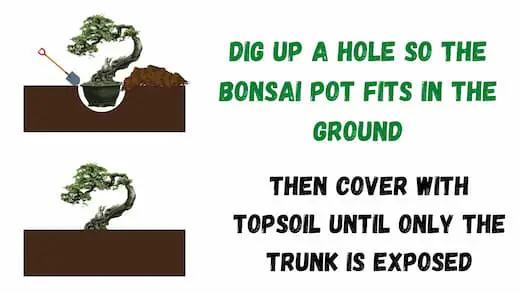
Styrofoam box
So styrofoam boxes add another level of protection, as instead of your bonsai being exposed outdoors, you will have your tree almost entirely submerged in a box.
Styrofoam boxes are a fantastic option due to their insulating properties and ability to survive harsh elements.
To use a styrofoam box, cut off or remove the lid of your box and place your bonsai in the center, an equal distance from all the box walls.
Cover the potting soil with mulch to add moisture to the soil, preventing water loss.
You can add tarp or plastic covers to the top to prevent rainfall during winter.
My recommendation for a styrofoam box would have to be the Polar Tech Styrofoam Box ( link takes you to Amazon), which should be large enough to keep two bonsai but also regulates temperature incredibly well.

Now for those in wetter environments or who fear that the rainwater might ruin your styrofoam box and the tramp on top of it (I live in the UK, trust me, this happens… a lot), consider investing in a water cooler.
You can do the same thing here – take the lid off and place it in your bonsai.
Then place the lid back on, opening the lid whenever the weather permits.
My recommendation for a water cooler or chill box would be the Cubix Ice Chest ( link takes you to Amazon), which comes in various colors and finishes. Even better, this lid is foldable, meaning you don’t necessarily need to remove it when placing it in your bonsai.

Move indoors into a cold spot
So at this stage, you will have exhausted all the options for keeping your bonsai tree outdoors; the following steps will all be around what to do when temperatures drop so low you need to move your bonsai tree indoors.
The first step will be simply moving your bonsai tree into a cold spot in your home.
I would aim to move it into a spot where it can still get plenty of sunlight but with temperatures almost the same as outdoors.
Keeping in a conservatory space or a garage will be the best option.
Aim to do this a few weeks before the coldest months of the year start just to prepare your bonsai tree.
Build a cold frame
So this is my favorite method of protecting outdoor bonsai trees in winter.
What’s good about it is once you have built a cold frame, you can reuse it yearly.
A cold frame is essentially just a wardrobe, cabinet, or box that is kept either outdoors or indoors in a cold spot in your house where you can store your bonsai tree during the winter months,
Cold frames are typically easy to access, meaning you can water and attend to your bonsai trees without worrying about the elements attacking your bonsai in winter.
Now I’ve written an entire post here talking about bonsai cold frames and how to build them.
To summarise the process of building one, however:
- Come up with a rough design.

- Decide how many spaces you need in your cold frame and what your cold frame will be made of

- Take note of where you will place your cold frame.
- Join your units together

- Build a door
- Add holes for ventilation or power
- Place your bonsai
Create a bonsai greenhouse
Finally, suppose you are lucky enough to grow traditional indoor bonsai trees such as ficus or Chinese elm trees outdoors and suddenly hit an icy winter. In that case, you will need to use some advanced methods to winterize your bonsai trees.
If your trees require warm hot temperatures even during the winter, I strongly recommend building a bonsai greenhouse.
Doing so will give you direct control of your trees’ temperature, light, and moisture requirements.
I would, however, avoid putting hardy bonsai trees into greenhouses.
This is because they will not go through the dormancy period that outdoor bonsai trees need to thrive.
If you are interested in how to build a bonsai greenhouse, I’ve written a post here.
Practice mindfulness
Finally, and arguably the most challenging part of how to protect your bonsai for winter, is just to practice patience.
Bonsai go through natural cycles of bloom and decay, meaning that winter is a natural part of the bonsai process.
After all, some bonsais species grow in frigid climates naturally, such as pine breeds, and withstand the snow during the winter months – so I’m sure your garden will be fine!
Mulch and bonsai winterization
Time to get your hands dirty!
Throughout this post, we have talked a fair bit about using mulch on top of your bonsai for your outdoor bonsai trees.
So why is this the case?
The dry winter air will constantly strip away the moisture from your tree branches, trunk, and soil.
This will remove a lot of vital nutrients that your tree will need, so it’s not uncommon for bonsai trees to dehydrate during the winter months if left outdoors.
One of the best things to do then is to apply an even layer of mulch over your bonsai pot and its soil until it is covered.
This mulch will add back to moisture your tree needs and will protect the topsoil from freezing or drying out.
Now there are loads of items that work well for this, but if found, a mix of materials usually works best.
A good option would be to mix up dry soil, pine leaves, and mulch in an evenly split mixture and then cover your plant.
Now, if you want to save some time (and a lot of mess), check out the Rubberiffic rubber mulch bag (the link takes you to Amazon), which is my recommendation and works particularly well for bonsai trees in winter and as natural insulation.
Alternatively, I like to add sphagnum moss to my bonsai mulch to add water further back to the tree.
Potting soil and protecting bonsai in winter
So another critical aspect of protecting bonsai trees in winter that you must consider is just how porous the soil is.
While most bonsai trees are kept in shallow pots, there is still a chance that if too much water is in the potting soil, your bonsai and its roots may freeze.
Alternatively, the wind will often strip away any moisture from your potting soil, causing it to dry.
We need to ensure that your soil is protected on two fronts.
The best way to get around this is by ensuring that your potting soil is porous.
I like to use an inorganic soil mix of akadama, volcanic ash rock, and sand for my outdoor bonsai trees during winter. As I find this tends to hold onto the perfect amount of water while preventing the soil from freezing.
The ratios I use then are as follows:
50% Akadama, 25% volcanic lava rock, 25% pumice
I’d also ensure that the topsoil of your bonsai is evenly covered with your mulch of choice to ensure that any ice cannot form directly on the soil, potentially causing your pot to freeze.
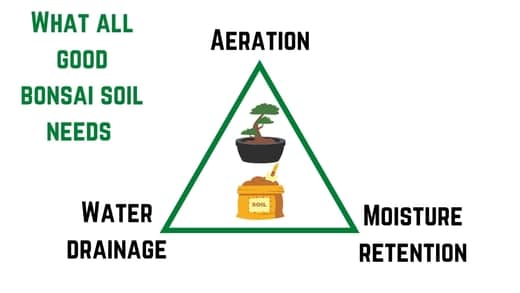
When does the cold kill bonsai trees in winter?
Most bonsai tree species will die if left outdoors during winter if temperatures drop below -10 degrees celsius (15 degrees Fahrenheit). While hardy bonsai trees like junipers can survive cold temperatures, should temperatures drop this low, they will freeze and will not recover.
Move your bonsai tree into a sheltered spot should temperatures drop this low.
What do bonsai trees need protection from during winter?
So as mentioned in this post, it’s not just the cold that bonsai trees need to be protected from, but excessive rainfall, dry winds, and solid weather.
Let’s explore these n more detail:
Dry winds
One of the most significant and misunderstood issues in the winter months is dry winds.
Dry winds essentially strip away any moisture from your bonsai tree.
It is not uncommon for bonsai trees to dehydrate in freezing winters.
To prevent this, consider using a wind guard to bounce the wind away from your bonsai tree.
Dry soil
One side effect of these dry winds is that the soil will dry out.
Without moisture in your soil, your bonsai tree will not be able to absorb the vital nutrients needed to protect your tree during the cold winter months.
To protect them, invest in porous soil and cover them with sphagnum moss or mulch to help bring moisture back to your tree.
Excessive rainfall
You will have to protect your bonsai from the wind and excessive rainfall.
While rainfall is generally suitable for bonsai, excessive amounts can easily lead to overwatering your bonsai during the winter.
To protect, consider placing your bonsai tree in a shelter, so it does not get flooded.
A cold frame, box, or under bench work well for this.
The cold
Finally, the cold is a significant factor that you must protect your bonsai tree from in winter.
If temperatures drop too low ( typically 15 degrees Fahrenheit or less for the most complex bonsai trees), your tree will likely die.
The excessive cold will cause the roots of your bonsai tree to freeze, preventing them from absorbing water or nutrients from the soil leading to a weaker tree.
To prevent this, move into a cold frame or indoors should temperatures drop too low.
Planting your bonsai in the ground may protect your bonsai roots from frost and cold.
How to keep your bonsai alive in winter
To keep your bonsai alive during winter, ensure your outdoor bonsai enters dormancy. When in its dormant stage, you can move it indoors into a cold spot or cover it with a tarp, as its need for light and water will be reduced—only water during dormancy when the topsoil is dry.
If your bonsai tree finishes its dormancy stage early or during the cold season, gradually expose it to the outdoors, provided it’s not too cold and cared for as you would normally.
Bonsai dormancy and winter
So we touched upon this earlier, but one of the big things you might have to deal with when winterizing your bonsai tree is dormancy stages.
Now, dormancy is the process that hardy bonsai trees usually go through for a few weeks during the winter.
These bonsai trees have an internal mechanism that shuts them down during the year’s cold months.
Essentially, your tree enters a period of hibernation/stasis while it stores its energy and prepares for the following spring.
Dormancy only happens to colder, hardier bonsai species, such as Juniper or pine trees.
Tropical bonsai tree species such as olive, elm, or ficus will not enter dormancy as they prefer warmer temperatures year-round.
Should you care for bonsai differently when they enter dormancy
When your bonsai tree enters dormancy, overall, you need to care for the bonsai tree less frequently than you would normally.
Watering your bonsai tree can be reduced from a few times per week to around once per week or two.
Only water when the topsoil is dry.
Most bonsai trees that enter dormancy will not require as much sunlight in the winter as they do in the summer, so you can move your tree indoors or under shelter without having to worry about your tree not getting enough sunlight.
What temperature is too cold for bonsai
Temperatures lower than -10 degrees C (15 degrees F) are too cold for outdoor bonsai trees. This includes hardy species such as Juniper and scots pine. You should not keep indoor bonsai trees such as ficus in temperatures lower than 15 degrees C (59 degrees F).
Bonsai winter timetable for the year
Many of you new to keeping bonsai might be experiencing your first winter.
As such, I put together a timetable below, which shows you what care to undertake.
Bonsai winterization method | When to use |
Cover with tarp | Mild winters only (between 0 to 5 degrees C) |
Provide shelter and cover | Mild winters only (between 0 to 5 degrees C) |
Styrofoam box | Moderately cool winters (between -5 to 0 degrees) |
Hay bales and wood frame | Moderately cool winters (between -5 to 0 degrees) |
Plant in the ground | Moderately cool winters (between -5 to 0 degrees) |
Season | Care required |
Spring | Move into a bright spot in your garden, water a few times per week, apply fertilizer once per month, check for insects. Training can be undertaken on your bonsai. |
Summer | Continue to keep in a bright spot in your garden but ensure you do not burn your tree. Check for watering needs once per day. Apply fertilizer once per month, check for insects. Training can be undertaken on your bonsai. |
Fall | Keep in a bright spot in your garden. Avoid fertilizng your tree. Water when the topsoil is dry (typically once to twice per week) if the fall is particularly cold start winterization progress. |
Winter | Start winterizing your bonsai tree if temperatures drop low enough. Avoid fertilization, Water once every one to two weeks wehn topsoil is dry. Sunlight can be reduced if your tree enters dormancy. |
Fukien Tea | Indoor |
Watering bonsai in winter
Watering is one key aspect of bonsai care that you will need to continue during winter.
For your indoor bonsai trees that remain indoors (such as ficus or elm) year-round, I strongly recommend continuing to water these bonsai as you would normally.
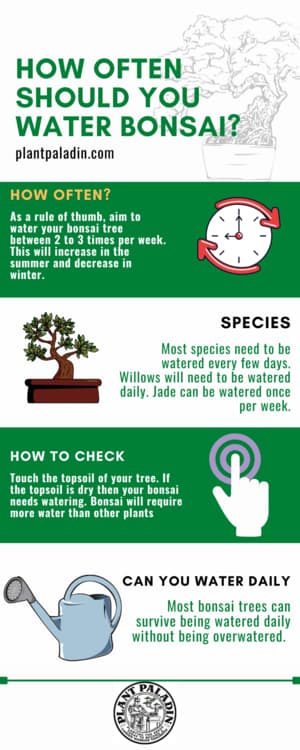
A few times per week will be enough; touch the topsoil to see if they are dry.
For outdoor bonsai trees like Juniper that you intend to keep outdoors during the winter, more care needs to be taken with watering your bonsai.
Watering will need to be reduced to only once a week.
This is because the excessive rain and snowfall will typically provide enough moisture for your tree.
You should, however, water your bonsai tree when the topsoil is dry.
Consider using mulch or mosses to help add moisture back to the soil should the soil be stripped of moisture from dry winds.
When your outdoor bonsai enters dormancy, you can typically reduce watering further to once every two weeks.
Can you keep your bonsai inside
I know what you’re thinking, why can’t we just move our bonsai trees inside during the winter months? Won’t that solve our problem?
Moving your bonsai trees indoors during the winter will be problematic as most bonsai trees are from temperate species (like Chinese Elm), which thrive better outdoors than indoors. Leaving these trees indoors causes a sudden change in temperature, which can damage your plant.
There are, however, exceptions to this rule.
Some bonsai species, particularly those from the Mediterranean, such as Pistaciaprefer a warmer climate year-round, so keeping these in a temperature-controlled garage during the winter works best.
However, you need to be careful; in the winter months, it is not uncommon for indoor bonsai trees to develop excess mold and white powder – to read more about how to deal with this, check out my post here.
If you plan on moving Mediterranean trees back into the garden in the spring months, you must ease them back in, exposing them during the warmest parts of the day and then keeping them away during the cold mornings and evenings.
Which bonsai plants can you keep indoors during winter?
While most bonsai plants work best outdoors, a few species can survive year-round indoors should you prefer to avoid winterizing your bonsai altogether.
These are mainly tropical and semi-tropical varieties that should be kept away from the cold in most instances and so make for ideal indoor bonsais:
These include:
- Chinese Elms
- Jade
- Ficus
- Fukien Tea
- Pomegranate
- Serissa
The science behind winterizing your bonsai trees
So many of you are likely wondering why we need to protect some bonsai species during the winter.
In winter, all plants and trees go dormant to protect themselves from the harsh climate – even evergreen trees.
They essentially pull back all the chlorophyll from the tree to protect themselves – it’s why trees go yellow and brown in autumn.
As most bonsai have a hard time adjusting to temperature, with the majority of mainstream bonsais on sale being imported recently, we must try to mimic the winter conditions from where the plants we purchased came from.
This typically means protecting certain species that need help.
When to avoid winterizing your bonsai tree?
Winterizing your bonsai tree can be avoided if you own an indoor one, such as a Chinese Elm, Ficus, or Jade tree. Winterizing can also be avoided should temperatures not drop low enough for your bonsai.
What to avoid when winterizing your bonsai
While winterizing your bonsai is an essential step for many of us every winter, it can be straightforward to over-winter your bonsai.
You can typically do this in the following ways:
- Protecting larger bonsai from winter – usually, more giant bonsai trees in larger pots will need less protection from the elements
- Remove the cold from your plant – Bonsai trees need protection but still need the cold. Removing the cold for a bonsai during winter may mean it starts to flourish, thinking it is spring.
- Stopping the pattern of freezing and thawing – It is essential to stop the nightly event of the freezing following by thawing in the morning regularly; even if your bonsai is protected, allow your bonsai to freeze once or twice to get the signal that it is time winter and then move into protection mode.
- Not taking your plant breed into account – All plant species are not created equal, so thinking that your bonsai will be fine in the winter without doing your due diligence is essential.
- Forgetting to water – while your bonsai may get enough water from the snow, the truth is you should still water your bonsai and, more specifically, the mulch surrounding it once every two weeks as a minimum – this will; also give you ample time to inspect your bonsai and see how it is getting on.
Survey on protecting bonsai in winter
Finally, I surveyed ten plant paladin readers who regularly protect bonsai in winter.
I asked them what method they typically undertake for winterization:
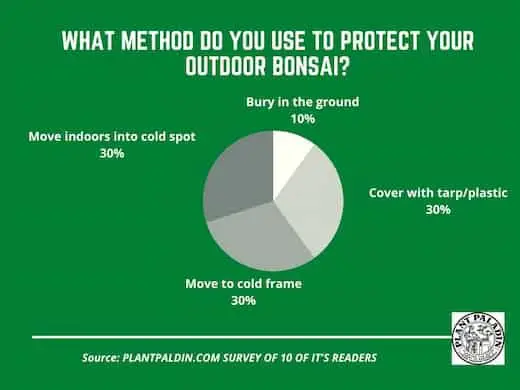
My top picks for the gear you will need!
So like I mentioned earlier, over the past three years of running PlantPaladin, hundreds of people have asked me for my recommendations on the best bonsai gear on the market.
Having spent thousands of dollars on bonsai items these past few years and tested at least 100 bonsai-specific products, I’ve listed my favorite products below – All of which I highly recommend and think you can get great value.
They can purchase directly by clicking the link to take them to Amazon.
Bonsai Tool Set: One of the significant challenges I’ve had is finding a toolset that was not only durable but didn’t break the bank. SOLIGT has recently developed a fantastic bonsai tool set that covers all the tools you need to trim, prune, and repot your trees. – You can grab it here.
Complete Bonsai Set: Many of you will want to grow your bonsai trees entirely from scratch, but finding the varicose seeds, pots, and other items in one place can be challenging. Leaves and Sole then have created a complete bonsai set that I’ve personally used that ticks all the boxes. You can grab it here.
Bonsai wire: The number of times I’ve run out of wire for my bonsai or purchased cheap bonsai wire that doesn’t do the job is embarrassing for me to admit. After a lot of trial and error, I found that using Hotop’s aluminum bonsai wire is one of the best options on the market. This can easily be used for both indoor and outdoor bonsai. You can grab it here.
This post was written by Fehed Nicass who has been passionate about bonsai for over 3 years. He currently resides in the UK and works in sales.






